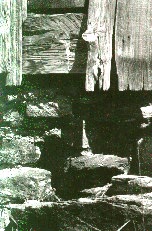TAKING
CARE OF YOUR OLD BARN
Tip # 4 - Make the Foundation Sound.
 A
sound, well-drained foundation is essential for maintaining any building.
Foundation failure can lead to structural collapse. Many buildings are
at risk today because during cold weather they no longer house animals,
whose body warmth prevented the heaving of foundation walls.
A
sound, well-drained foundation is essential for maintaining any building.
Foundation failure can lead to structural collapse. Many buildings are
at risk today because during cold weather they no longer house animals,
whose body warmth prevented the heaving of foundation walls.
Fieldstone forms the foundations
for most historic agricultural buildings built before about 1915. The earliest
barns and many smaller buildings simply had large stones under main posts
for support. Shallow stone walls or piers "dry laid" (without
mortar between stones) supported most barns before about 1840. After that,
bank barns began a trend of usable basements that required more extensive
masonry, often dry laid but sometimes mortared. In the twentieth century,
concrete replaced fieldstone in foundations, a trend accelerated by sanitary
regulations requiring washable concrete floors in dairy barns.
Poor drainage and frost heaving
are the primary foundation problems. Drainage problems occur when
rain and snow runoff from roofs or nearby roads, yards, and fields drains
into the foundation rather than away from the building or when migrating
groundwater flows into the foundation. Poor drainage contributes to the
problems of frost heaving, which is caused by the natural freeze-thaw cycle
of the soil. Frost heaving will most greatly affect a foundation that is
not heated or is not secure in the ground below the frost level. Dry laid
and even mortared stone walls may bulge and collapse, and concrete floors
may buckle. Heaving will also put stress on the structural frame of the
building, and may put parts of it in contact with the soil, encouraging
rot and other problems. Water pressure in the soil can crack even the strongest
reinforced concrete if the drainage around a building is not good.
Improving drainage is
one way to help avoid costly foundation problems. The soil around a
foundation should be sloped so that surface water flows away from the building.
Do not allow vegetation, debris and other materials that retain water to
accumulate around the foundation. Closing up openings and sheathing foundations
or banking them with hay may help reduce cold penetration and frost action
(but remember to remove any banking material in the spring to prevent water
damage). Underground drains within the foundation may sometimes be necessary;
they should flow to the surface well beyond the foundation. If you are
rebuilding a foundation wall or constructing a new foundation, dig a trench
around the perimeter and install drainage materials, including drain tile,
crushed stone, and water barrier cloth.
Repairing a foundation often
involves jacking up the building, rebuilding its underpinning, and grading
the surface so that water drains away from the building. Some contractors
have developed innovative methods of pushing heaved stone foundations back
into place with jacks and heavy equipment. Sometimes a cracked or heaved
foundation can be stabilized with a reinforced concrete buttress, but if
the area is unheated a concrete buttress on a stone wall will eventually
separate from the stone. If a stone wall is severely heaved or has collapsed,
however, the best repair will be to rebuild the wall using the original
stones. Consider a new reinforced concrete wall if the existing foundation
is not historically important. When rebuilding or installing a new wall
or piers, place the footings below the frost level (as much as five or
six feet below grade in Vermont), and install good drainage (see above).
Potential archeological remains
should always be considered when working on foundations.
Disturbing as small an area around the foundation as possible will help
to preserve any remains. If while digging you discover any unusual and
notable artifacts, consider contacting the State Archeologist at the Vermont
Division for Historic Preservation.
© 1995 Vermont Division for Historic Preservation
and Vermont Housing and Conservation Board. All rights reserved.
Forward to Barn Tip #5...
Back to the Table of Contents...
 A
sound, well-drained foundation is essential for maintaining any building.
Foundation failure can lead to structural collapse. Many buildings are
at risk today because during cold weather they no longer house animals,
whose body warmth prevented the heaving of foundation walls.
A
sound, well-drained foundation is essential for maintaining any building.
Foundation failure can lead to structural collapse. Many buildings are
at risk today because during cold weather they no longer house animals,
whose body warmth prevented the heaving of foundation walls.